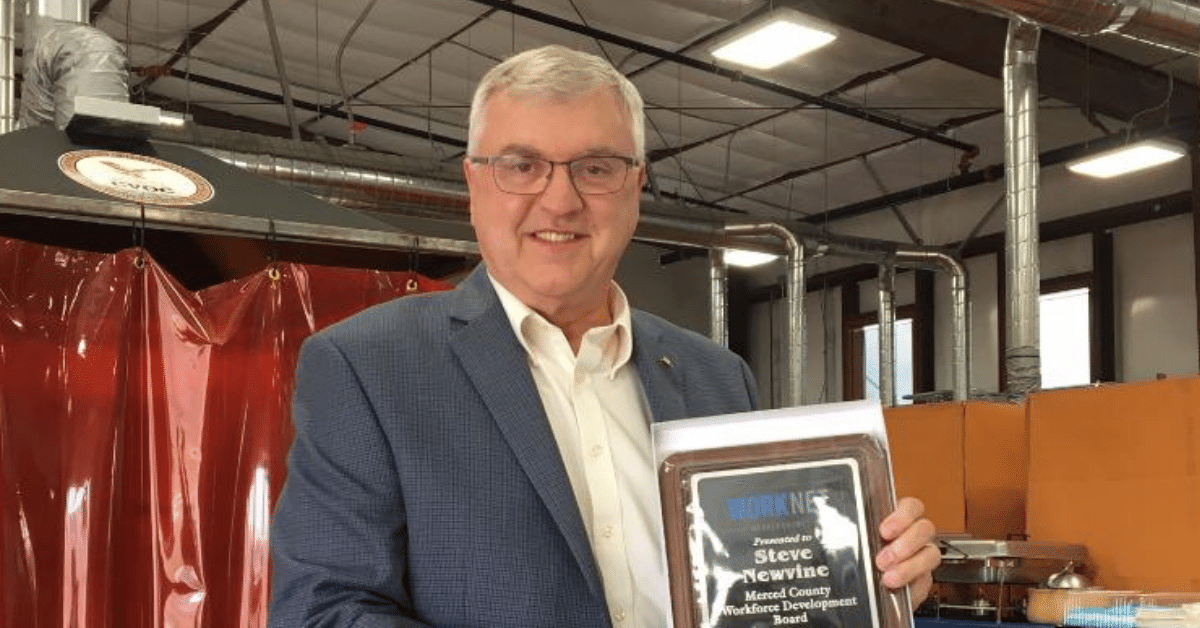
Signs of the COVID Times
The marquee sign at Merced Mall reminds people that Big Lots and Target are open. Photo: Steve Newvine
How Merced is coping in the corona virus era
The marquee sign in front of Merced Mall has become a barometer of our community’s response to COVID.
Immediately after Governor Newsom imposed quarantine at home restrictions on March 19, the sign informed passersby that the Mall was closed.
It is a sign of the changing times in Merced.
A clerk at a neighboring store told me how he felt when he drove past the Mall with all the empty parking spaces.
“It’s eerie,” he said without breaking his smile. “I never thought I’d see a time like this.”
In the days since the restrictions were announced, the sign was changed to reflect that the nearby Target and Big Lot stores were open.
In the foreground heading East on Olive, the sign promoting the Mall expansion project remains.
Barriers have been placed at the parking lot entrances at St. Patrick’s Church in Merced. Photo: Steve Newvine
We’re now in the COVID era where church parking lots are empty, and lines form a half hour before some grocery stores open.
The churchgoers turn to televised services on line or on their televisions.
The shoppers are hoping to find TP, paper towels, hand sanitizer, and a myriad of food products that seem to disappear overnight.
Some call it the COVID era. Others call it the hoarding era.
A grocery store clerk lamented, “In the store I asked a man I know who is single why he needed two large packages of toilet paper. He just looked at me and said ‘Why should you care?”
Empty paper product shelves symbolize the state of flux in area retailing. Photo: Steve Newvine
On a lighter note, I recognized an acquaintance waiting in line at a store that opened early one weekday morning just for seniors.
He told me, “I feel as though I’m at my fiftieth high school reunion with all these familiar faces.”
We know this crisis will change the face of commerce in many ways. Restaurants are converting to take-out and delivery transactions as dining rooms are shut down.
The iconic Branding Iron sign waits for the day the popular steak house reopens. Photo: Steve Newvine
On Sixteenth Street, a familiar neon sign has gone dark. Merced’s Branding Iron sent a message on Facebook in late March saying they were shutting down until further notice.
The management thanked customers for their support in the post adding, “Alright, so we kept going as long as we could but the time has come now when we HAVE to shut down completely until further notice.”
While the primary shopping area is closed to shoppers, construction crews continue their work on the Merced Mall expansion. Photo: Steve Newvine
The signs we see, whether in front of the Mall, or taped to an empty store shelf, each share a part of the COVID story’s impact on our city. Some may offer a ray of hope for the future.
Construction continues on the Mall’s expansion project. The project remains on schedule.
We’ll know things are getting better when the marquee changes one more time at the Mall, and when the neon is blazing again at the Branding Iron.
Steve Newvine lives in Merced.
He has written Course Corrections, My Golf Truth, Fiction, and Philosophy. The book is available at Lulu.com
Merced’s Japan Internment Memorial now 10 Years Old
Site marks the place where 4,669 were held during WW II
The Japan Internment Memorial at the Merced County Fairgrounds. Photo- Steve Newvine
Marlene Tanioka remembers turning five years old behind the fences at the Merced Assembly Center during World War II.
Her family was among the 4,669 Americans of Japanese ancestry from Merced and surrounding areas who were incarcerated at the Center as part of President Franklin D. Roosevelt’s Executive Order that established the internment.
“I had forgotten what home looked like,” Marlene said as she visited the Memorial again recently at the Merced County Fairgrounds.
Today’s home of the Merced County Fairgrounds is the site where the Assembly Center was built in 1942.
Marlene Tanioka and Patti Kishi view with bronze depiction of a Japanese American family and their belongings as the family is about to be incarcerated at the Merced Internment Memorial. Photo: Steve Newvine
According to the Merced Assembly Center’s website ( http://mercedassemblycenter.org/), construction of the buildings at the site began in March of 1942.
More than two-hundred, fifty buildings were constructed. Most of the buildings were barracks that held five families each.
The rest were mess halls, laundries, shower, and toilet facilities.
All of it was fenced in with barbed wire.
The Merced Assembly Center Memorial includes a wall with the names of individuals incarcerated at the Center during World War II. Photo- Steve Newvine
Within that barbed wire, the site functioned like a fully functional community. Temporary schools were opened for the one-thousand children within the group.
Religious services were held on the site. Emergency departments such as police and fire were set up.
The Center closed later that year in September. Most of the internees were moved farther inland to Colorado until the war was over.
Patti Kishi views the Memorial Garden at the Merced Assembly Center Memorial. Photo- Steve Newvine
The memorial was dedicated on February 20, 2010 at the County Fairgrounds site on Martin Luther King Drive in Merced.
Building the Memorial a little over a decade ago was easier than an earlier effort back in 1980s to have a historical marker placed at the site.
“The Fair Board at that time back in the eighties was not as enthusiastic about even a historical marker,” said Patti Kishi whose father was incarcerated at the Center during World War II.
“They eventually came around.”
A marker was placed outside the Fairgrounds footprint.
After learning about a federal grant available to build a memorial, members of two local Japanese American groups took up the challenge.
This time, when the 2008 Fair Board was approached about putting up this Memorial within the Fairgrounds, it was very receptive to the idea. They granted the six-hundred square feet of space to place the Memorial at a prominent spot inside the Fairgrounds.
The grant helped spark fund raising. By 2010, the Memorial opened to the public.
One of the information panels at the Memorial has photographs of area Japanese American soldiers who served in the US Armed Services during World War II. Photo: Steve Newvine
The Memorial features written accounts of life in the internment centers. There’s a wall listing the names of all the internees. Behind that wall is a reflection garden.
There’s also a panel honoring Japanese Americans who served in the US Armed Services during World War II.
Patti Kishi says there is really only one thing she hopes visitors take away from their time at the memorial.
“History,” she says. “It’s our history, our County’s history. It’s important to understand what happened here so that it never happens again.”
The barbed wire image is included in the plaque descriptions at the Merced Assembly Center Memorial. Photo: Steve Newvine
For Marlene Tanioka, memories from that period of time are still burned into her memory.
As a five-year old, she feared forgetting what her real home looked like. But her older sister took that worry away.
The sister drew a picture of the family farm so that Marlene could be reminded of what her home looked like.
“She drew a row of walnut trees, two barns, and a farmhouse,” Marlene said. “And when we were finally able to go home, it looked just like the picture she drew: a row of walnut trees, two barns, and a farmhouse.”
She knew then, she was home.
Steve Newvine lives in Merced.
His book California Back Roads - includes a section on the Japanese American Internment icons on display at the Livingston Historical Society Museum.


















To explore Steve Newvine's complete collection of books, simply click on the link below.
CLICK HERE
Steve is also open to delivering speeches for service club programs and other public speaking engagements.
Contact him at: SteveNewvine@sbcglobal.net